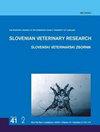RABBIT MEAT AS A POTENTIAL SOURCE OF STAPHYLOCOCCUS AUREUS AND SALMONELLA SPP.
IF 0.6
4区 农林科学
Q4 VETERINARY SCIENCES
引用次数: 0
Abstract
Rabbit meat and offal are considered valuable sources of high biological value animal protein. Rabbit meat is rich in essential amino acids, low in cholesterol, and contains considerable amounts of trace elements such as calcium, magnesium, and zinc. However, the potential contribution of rabbit meat and offal in the transmission of foodborne pathogens such as Staphylococcus aureus (S. aureus) and Salmonella spp. is neglected. Therefore, this study was conducted first to investigate the prevalence rates of S. aureus and Salmonella spp. in the retailed rabbit meat at Sharkia Governorate, Egypt. Second, serological identification of the isolated bacteria was followed. Detection of S. aureus-enterotoxins and Salmonella-virulence-associated genes was also done using PCR. Antimicrobial susceptibility testing of the recovered bacterial isolates was additionally examined. The acquired results showed that 17% of the investigated samples of rabbit meat contained S. aureus. Where S. aureus was isolated from the investigated rabbit's breast, thigh, liver, and kidney at 20%, 24%, 12%, and 12% of each, respectively. Salmonella spp. was isolated at 13%. Salmonella spp. was isolated from the investigated rabbit thigh, liver, breast, and kidney at 16%, 16%, 12%, and 8%, respectively. Four different strains of Salmonella spp namely, S. Typhimurium, S. Kentucky, S. Virchow, and S. Infantis were recovered in the current study. The recovered S. aureus and Salmonella spp. harbored enterotoxins and virulence attributes with multidrug resistance. Therefore, strict hygienic measures should be followed during the processing and handling of rabbit meat and offal.兔肉是金黄色葡萄球菌和沙门氏菌的潜在来源。
兔肉和内脏被认为是高生物价值动物蛋白的宝贵来源。兔肉富含必需氨基酸,胆固醇含量低,并含有相当数量的微量元素,如钙、镁和锌。然而,兔肉和内脏在传播金黄色葡萄球菌(金黄色葡萄球菌)和沙门氏菌等食源性病原体中的潜在贡献被忽视了。因此,本研究首先调查了埃及Sharkia省零售兔肉中金黄色葡萄球菌和沙门氏菌的流行率。其次,对分离的细菌进行血清学鉴定。金黄色葡萄球菌肠毒素和沙门氏菌毒力相关基因也采用PCR检测。对回收的细菌进行药敏试验。结果表明,调查的兔肉样品中有17%含有金黄色葡萄球菌。其中,金黄色葡萄球菌分别从兔的乳房、大腿、肝脏和肾脏中分离出来,分别占20%、24%、12%和12%。沙门氏菌的分离率为13%。从家兔大腿、肝脏、乳房和肾脏中分离出沙门氏菌,分离率分别为16%、16%、12%和8%。在本研究中回收了四种不同的沙门氏菌,即鼠伤寒沙门氏菌、肯塔基沙门氏菌、Virchow沙门氏菌和婴儿沙门氏菌。回收的金黄色葡萄球菌和沙门氏菌具有多重耐药的肠毒素和毒力属性。因此,在加工和处理兔肉和内脏时,应采取严格的卫生措施。
本文章由计算机程序翻译,如有差异,请以英文原文为准。
求助全文
约1分钟内获得全文
求助全文
来源期刊

Slovenian Veterinary Research
VETERINARY SCIENCES-
CiteScore
0.60
自引率
0.00%
发文量
12
审稿时长
>12 weeks
期刊介绍:
SLOVENIAN VETERINARY RESEARCH (ISSN 1580-4003) publishes original articles, which report the results of original research in most areas of biomedicine. The journal also publishes review articles dealing with rapidly developing areas of biomedicine or which update understanding of classical fields of biomedicine, as well as case reports, shorter scientific contributions, letters to the editor, etc.; which have not been published or are under consideration for publication elsewhere. Only papers written in English can be considered.
 求助内容:
求助内容: 应助结果提醒方式:
应助结果提醒方式:


